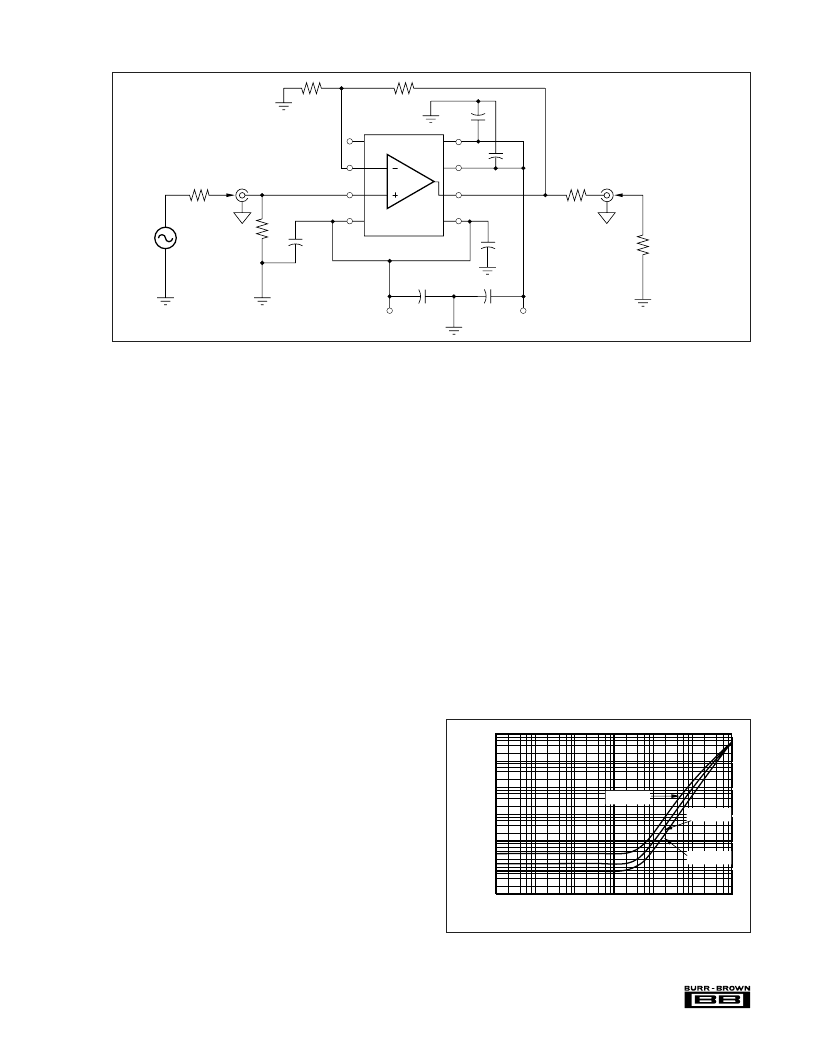- 您現(xiàn)在的位置:買賣IC網(wǎng) > PDF目錄383693 > OPA628AU Low Distortion Wideband OPERATIONAL AMPLIFIER PDF資料下載
參數(shù)資料
| 型號(hào): | OPA628AU |
| 英文描述: | Low Distortion Wideband OPERATIONAL AMPLIFIER |
| 中文描述: | 低失真寬帶運(yùn)算放大器 |
| 文件頁數(shù): | 9/13頁 |
| 文件大小: | 172K |
| 代理商: | OPA628AU |

9
OPA628
10
1
100m
10m
1m
100μ
10μ
100
1k
10k
100k
1M
10M
100M
Frequency (Hz)
S
)
G = +5V/V
G = +2V/V
G = +1V/V
FIGURE 1. Configuration For Testing Differential Gain/Phase.
shown in Typical Performance Curves. Include the contribu-
tion of the feedback resistance when calculating the effec-
tive load resistance at the amplifier output. A high perfor-
mance spectrum analyzer such as the HP3585B should be
used to measure distortion.
Two-tone, third-order intermodulation distortion (IM) is an
important parameter for many RF amplifier applications.
The specification table shows the OPA628’s two-tone, third
order IM intercept at 5MHz and 10MHz. For these measure-
ments, tones were spaced 200kHz apart. This data is particu-
larly useful for determining the magnitude of the third-order
IM products. The magnitude of the third-order IM products
can be easily calculated from the expression:
Third IM = 2(OPI
3
P – P
O
)
where OPI
3
P = third-order output intercept, dBm
P
O
= output level/tone, dBm/tone
Third IM = third-order intermodulation ratio
below each output tone, dB
As an example, with OPI
3
P = 60dBm, for P
O
= 10dBm, the
third order IM = 2(60 – 10) = 100dB below either 10dBm
tone. The OPA628’s low IM makes the device an excellent
choice for a variety of RF signal processing applications. In
order to obtain the full low distortion performance of the
OPA628, it is imperative to follow the recommendations
described in the “Printed Circuit Board Guidelines” section.
OUTPUT DRIVE CAPABILITY
The OPA628 has been optimized for low distortion perfor-
mance with back terminated 50
and 75
loads (R
LOAD
=
100
and 150
,
respectively). However, it is capable of
driving 6Vpp into a 50
load with a sacrifice in distortion.
This high-output drive capability makes the OPA628 an
ideal choice for a wide range of RF, IF, and video applica-
tions. All transmission lines should be terminated with the
characteristic impedance of the transmission line.
Internal current-limiting circuitry limits output current to
about 130mA at 25
°
C. This prevents damage from acciden-
tal shorts to common and eliminates the need for external
current-limiting circuitry. Although the device can with-
stand momentary shorts to either power supply, it is not
recommended.
Many demanding high-speed applications such as ADC/
DAC
buffers require op amps with low wideband output
impedance. For example, low output impedance is essential
when driving the signal-dependent capacitances at the inputs
of flash A/D converters. As shown in Figure 2, the OPA628
maintains very low closed-loop output impedance over fre-
quency. Closed-loop output impedance increases with fre-
quency since loop gain is decreasing with frequency.
NOISE FIGURE
The OPA628’s voltage and current noise spectral densities
are specified in the Typical Performance Curves. For RF
applications, however, Noise Figure (NF) is often the pre-
ferred noise specification since it allows system noise per-
formance to be more easily calculated. The OPA628’s Noise
Figure vs Source Resistance is shown in Figure 3 for
frequencies above 1MHz.
FIGURE 2. Small Signal Output Impedance vs Frequency.
OPA628
510
510
75
0.1μF
+
Tektronix
TSG 130A
1
2
3
4
8
7
6
5
+5V
C = 10μF
C = 10μF
–5V
0.1μF
0.1μF
0.1μF
75
75
75
Tektronix
VM700A
V
O
DUT
相關(guān)PDF資料 |
PDF描述 |
|---|---|
| OPA628 | Low Distortion Wideband OPERATIONAL AMPLIFIER |
| OPA654 | Wide Bandwidth, High Output Current Difet OPERATIONAL AMPLIFIER |
| OPA654AM | Wide Bandwidth, High Output Current Difet OPERATIONAL AMPLIFIER |
| OPA655 | Wideband, Unity Gain Stable, FET-Input OPERATIONAL AMPLIFIER |
| OPA655P | Wideband, Unity Gain Stable, FET-Input OPERATIONAL AMPLIFIER |
相關(guān)代理商/技術(shù)參數(shù) |
參數(shù)描述 |
|---|---|
| OPA628U | 制造商:BB 制造商全稱:BB 功能描述:EVALUATION FIXTURE |
| OPA62K5 | 制造商:TI 制造商全稱:Texas Instruments 功能描述:Wideband, Unity-Gain Stable, FET-Input OPERATIONAL AMPLIFIER |
| OPA631 | 制造商:BB 制造商全稱:BB 功能描述:Low Power, Single-Supply OPERATIONAL AMPLIFIERS TM |
| OPA631/OPA632 | 制造商:BB 制造商全稱:BB 功能描述:OPA631. OPA632 - SpeedPlus Low Power. Single-Supply OPERATIONAL AMPLIFIERS |
| OPA6316 | 制造商:KODENSHI 制造商全稱:KODENSHI KOREA CORP. 功能描述:Orange LED Chip |
發(fā)布緊急采購,3分鐘左右您將得到回復(fù)。